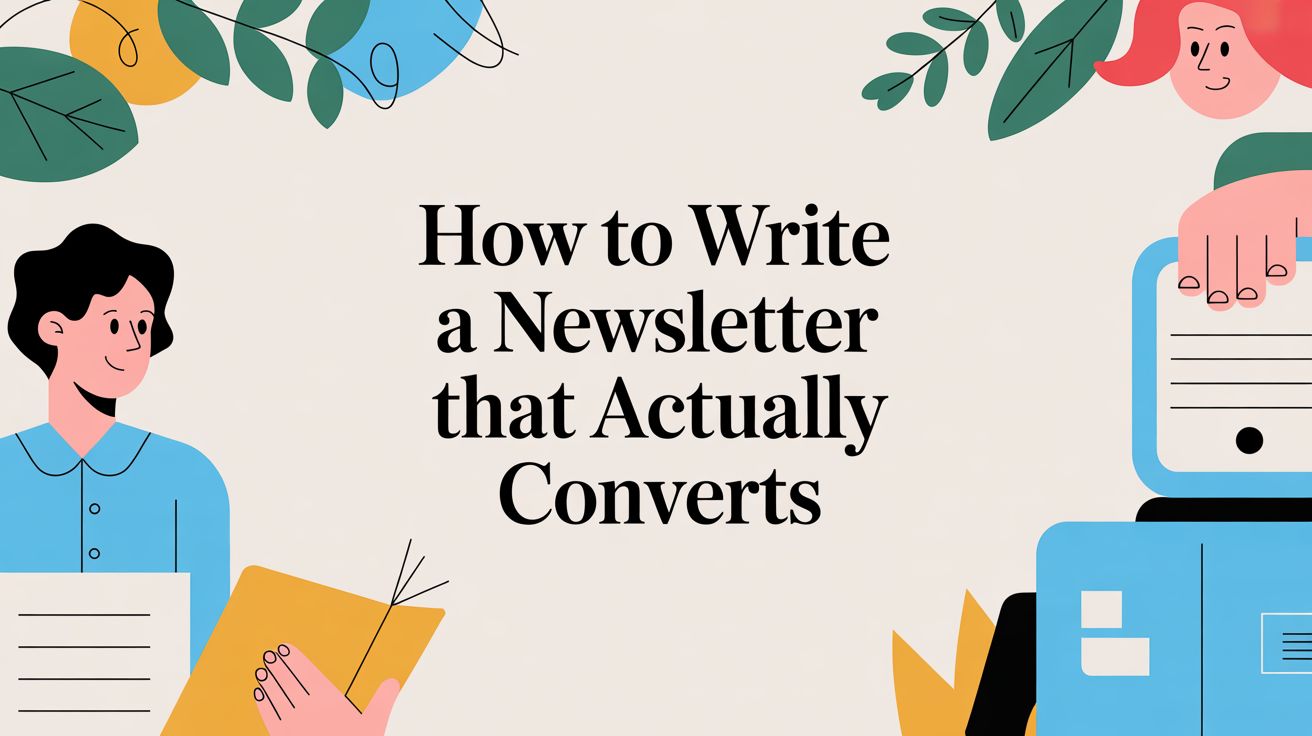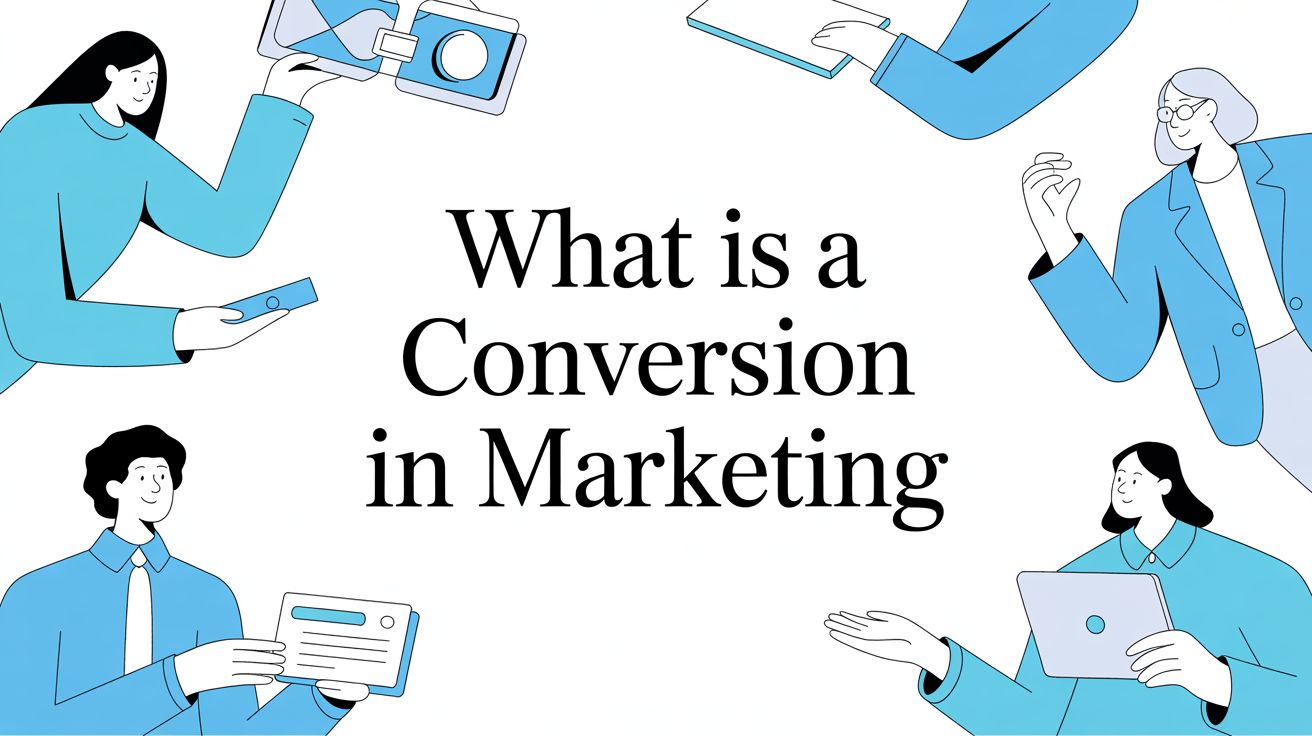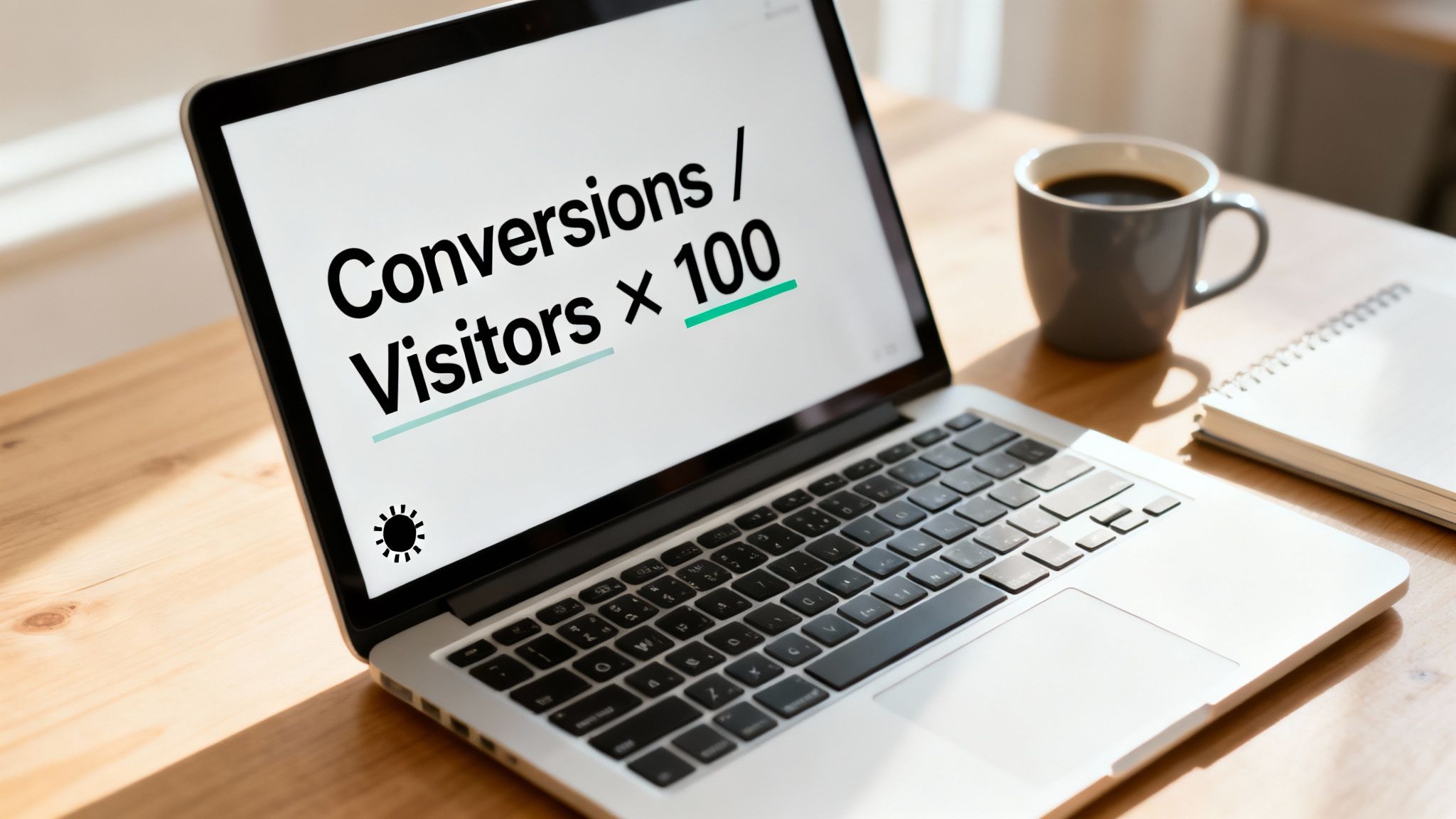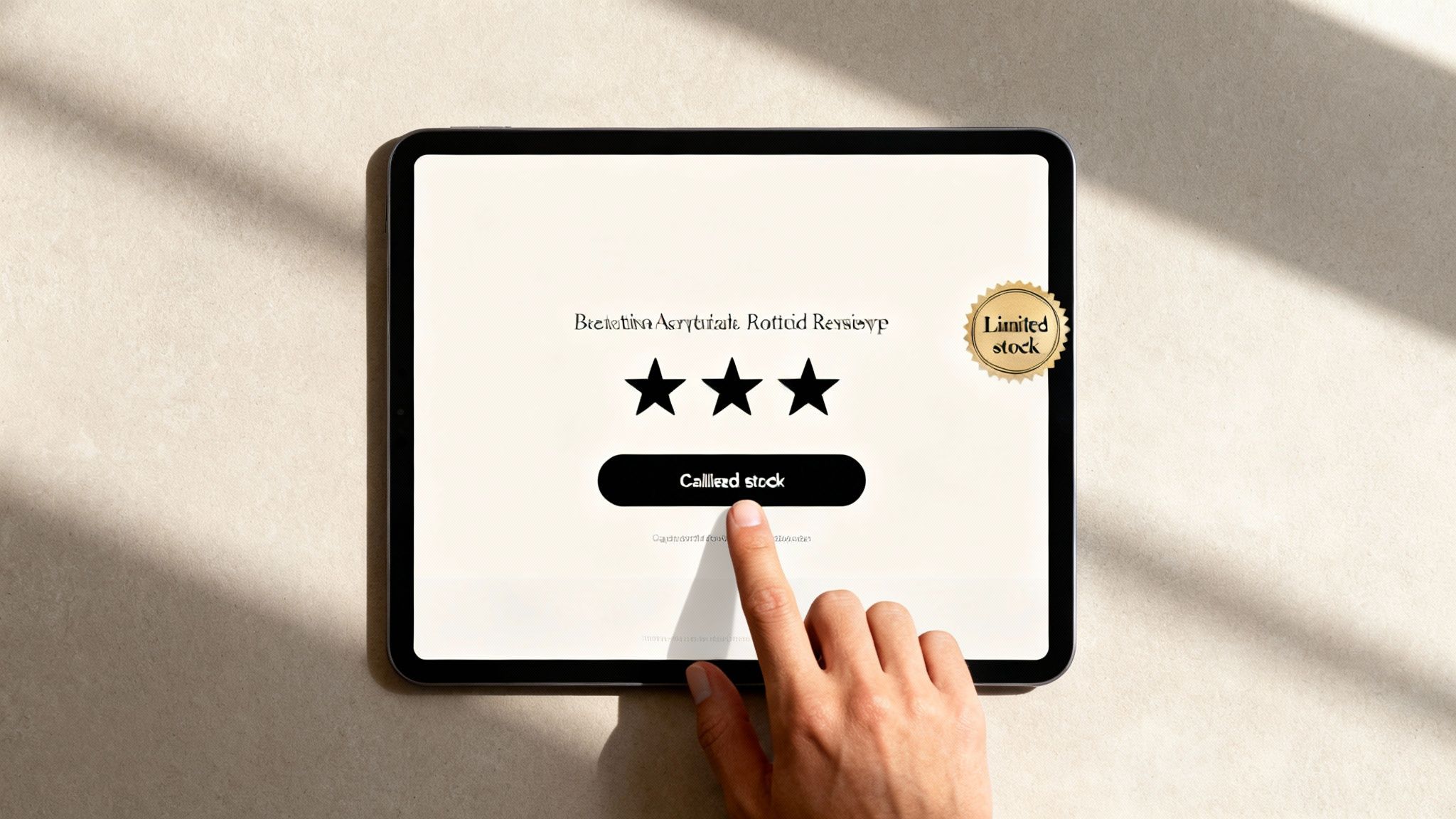
What Is a Conversion in Marketing: A Guide to Driving Revenue

When you hear "marketing conversion," your mind probably jumps to a sale. A customer clicks "buy," you generate revenue, and the conversion is complete. Right?
Yes, but that's only part of the story. A sale is a critical conversion, but the term encompasses a much wider range of actions that directly impact your bottom line.
A conversion in marketing is a specific, desired action a visitor takes that moves them closer to becoming a paying customer. It’s the measurable moment a passive browser becomes an active participant in your sales funnel. These actions are the most important signposts on the customer journey, telling you what's working, what's not, and how to optimize for profitability.
Defining Marketing Conversions Beyond Just Sales
At its core, a conversion happens when a website visitor completes a goal you've set for them. These goals are the building blocks of revenue generation. Tracking them is how you measure the true effectiveness of your marketing efforts and, ultimately, your return on investment (ROI).
However, not all conversions carry the same weight. They fall into two distinct camps, each playing a vital role in guiding a prospect from initial curiosity to a final purchase.
Macro vs Micro Conversions
Macro-conversions are the primary goals that directly translate to revenue. Think of these as the finish line that drives business growth. For an ecommerce store, the ultimate macro-conversion is a completed purchase. For a B2B service, it might be a signed contract or a demo request that enters the sales pipeline.
Micro-conversions are the smaller, supporting actions a user takes along the way. These actions signal interest and are crucial for building the relationship that precedes a sale. Based on the psychological principle of commitment and consistency, getting a user to agree to a small action (like signing up for a newsletter) makes them more likely to agree to a larger one later (like making a purchase). Actions like subscribing to your email list, adding a product to a cart, or downloading a guide are all crucial micro-conversions.
This infographic shows how these smaller steps build up to the main revenue-generating goal.
Here's a table breaking down some common examples to make the distinction even clearer.
Examples of Macro vs Micro Conversions
| Conversion Type | Business Goal | Example Action |
|---|---|---|
| Macro | Drive Direct Revenue | A customer completes a purchase on an ecommerce site. |
| Micro | Build an Email List | A visitor subscribes to your weekly newsletter. |
| Macro | Generate High-Quality Leads | A potential client fills out a "Request a Quote" form. |
| Micro | Gauge Purchase Intent | A shopper adds an item to their online cart. |
| Micro | Nurture Prospects | A user downloads a case study or a white paper. |
Notice how micro-conversions support the macro goals. You can't achieve the major revenue win without encouraging the small commitments that come first.
It's all about perspective. Across Google Ads, the average conversion rate is around 7.52%, but this figure is almost meaningless without context. It swings wildly depending on the industry and, more importantly, the specific action you're measuring. You can dive deeper into Google Ads benchmarks to see how your industry stacks up.
It’s easy to get caught up in vanity metrics like website traffic, social media likes, and high click-through rates. But these metrics don’t protect profit margins.
Clicks show interest, but a conversion in marketing shows intent. It’s the critical moment when someone goes from simply browsing to becoming a qualified lead or a paying customer. It's the only real way to measure the financial pulse of your marketing strategy.
When you focus on conversions, your entire perspective shifts from audience attraction to revenue generation. Every single conversion impacts your bottom line, showing you what’s actually driving growth and what’s just noise.
The Business Impact of Conversion Tracking
Tracking conversions isn't just a marketing task—it's a core business intelligence function. When you optimize for conversions, you're not just tweaking a metric; you're directly shaping financial outcomes that determine your ability to grow and scale.
A higher conversion rate sends powerful ripples through your entire business:
- It lowers your Customer Acquisition Cost (CAC): When a higher percentage of your visitors convert, you spend less to acquire each new customer. Your ad budget immediately becomes more efficient, directly impacting profitability.
- It boosts your Customer Lifetime Value (LTV): A smooth, optimized conversion path creates a superior customer experience. This fosters loyalty and encourages repeat purchases, which is the key driver of high LTV.
- It protects your profit margins: By cutting wasteful ad spend on campaigns that get clicks but no action, you're directly protecting your profitability. That capital can then be reinvested in channels with proven ROI.
Actionable Takeaway: Stop celebrating traffic. A conversion is when someone doesn't just walk past your store but comes inside, engages with your products, and heads to the checkout counter. Shift your primary reporting from traffic to conversion rate.
For Shopify merchants, this data is gold for inventory management. It helps you identify top-performing products, anticipate demand, and avoid costly overstocking or stockouts during peak seasons.
This is where sophisticated marketing psychology differentiates itself. A basic countdown timer might create a click out of superficial urgency. In contrast, a well-timed, psychologically grounded urgency campaign—what we call "Moments" at Quikly—leverages behavioral principles like scarcity and anticipation to create genuine motivation to buy. One inflates vanity metrics; the other builds your business by turning the science of consumer behavior into predictable revenue.
What Do Different Marketing Conversions Look Like?
While it’s helpful to think in terms of macro and micro goals, the actual conversions you’ll track will look completely different depending on your business. What a B2B software company wants a user to do is worlds away from the goals of a direct-to-consumer (DTC) fashion brand.
Pinpointing these unique, high-value actions is how you focus your marketing efforts where they'll have the biggest impact. For instance, a Shopify Plus enterprise lives and dies by e-commerce actions, while a service-based business is all about generating qualified leads for its sales team.
Key Conversion Types By Business Model
Let’s get more specific and break down a few common conversion types.
Lead Generation Conversions: This is the lifeblood of B2B and service-based companies. The primary goal is to capture a prospect's information so a sales team can nurture them toward a purchase. Think demo requests, quote inquiries, or free trial sign-ups. Understanding the marketing qualified leads (MQLs) definition is crucial here, as it helps you distinguish between genuinely interested prospects and those who are just browsing.
E-commerce Conversions: For any DTC brand, these are the actions that signal clear purchase intent. We're talking about key moments like adding an item to the cart, starting the checkout process, and, of course, the ultimate goal: completing a purchase. These conversions are particularly critical during the consideration stage in the consumer journey.
Engagement Conversions: These are top-of-funnel actions that build your brand’s authority and nurture potential customers. Downloading an ebook, subscribing to a newsletter, or watching a webinar all fall into this category. These smaller commitments keep your brand top-of-mind and build the trust needed to eventually ask for the sale.
Actionable Takeaway: Align your conversion goals with your specific business model. This ensures every marketing dollar is spent driving actions that directly contribute to revenue and growth. This focused approach provides clarity and delivers measurable results.
How to Calculate and Track Your Conversion Rate
You can't improve what you don't measure. This is the absolute truth in marketing. Without tracking, you’re making decisions based on guesswork. Understanding your conversion rate is the first step toward making smart, data-driven decisions that grow your business.

The formula itself is straightforward, providing a high-level snapshot of your performance.
(Total Number of Conversions / Total Number of Visitors) x 100 = Conversion Rate %
For example, if your product page received 10,000 visitors last month and 250 of them made a purchase, your ecommerce conversion rate would be 2.5%.
Getting Your Tracking Systems in Order
While the formula is simple, it’s useless without accurate tracking. If your data is flawed, your conversion rate is a meaningless number. The real work is setting up your analytics tools to capture every important user action.
Here are the essentials:
- Google Analytics Goals: This is your foundation. Set up specific goals to track everything from newsletter signups (micro-conversions) to completed sales (macro-conversions). This centralizes your website performance data.
- Ad Platform Pixels: If you run paid campaigns on platforms like Meta or Google Ads, installing a tracking pixel is essential. These code snippets track users who click your ads, allowing you to attribute conversions directly to specific campaigns and measure your true Return on Ad Spend (ROAS).
Shopify-Specific Guidance
For Shopify store owners, the platform's built-in analytics automatically track sales, add-to-carts, and initiated checkouts.
To get the full picture, integrate your Shopify store with Google Analytics. This unlocks deeper insights into user behavior, traffic sources, and the entire customer journey. For Shopify Plus merchants, this advanced tracking is critical for understanding multi-channel attribution and optimizing large-scale ad budgets.
Nailing your tracking is the bedrock for figuring out how to measure marketing campaign effectiveness. It ensures every dollar you spend is accounted for and working as hard as possible.
Proven Strategies to Increase Your Conversion Rate
Knowing your conversion rate is the first step, but improving it is where real growth happens. It’s about moving past basic tactics like generic pop-ups and digging into the science of consumer psychology. The goal is to create a customer journey that feels intuitive and guides visitors toward purchase.

This is not about manipulation; it’s about understanding the core behavioral principles that drive action. When applied correctly, these concepts build an experience that is engaging and persuasive because it feels genuinely helpful, not high-pressure.
Tapping into Behavioral Economics
A simple countdown timer can create superficial urgency, but it often lacks the psychological depth to move the needle on revenue. Sophisticated urgency marketing, grounded in behavioral science, is a different class of tool that taps into fundamental human drivers.
- Scacity: Highlighting limited inventory isn't just a sales tactic; it triggers a powerful fear of missing out (FOMO), a concept well-documented in consumer psychology. When an item is perceived as rare, its value increases in our minds.
- Social Proof: We are social creatures who look to others for cues. Displaying authentic customer reviews, testimonials, and user-generated content builds immediate trust. As behavioral economics research shows, people are far more likely to act if they see that others have done so successfully.
- Anticipation: Building genuine excitement for a future event, like a product drop or a major sale, creates a powerful sense of anticipation. This primes customers to convert the moment the opportunity becomes available.
Actionable Takeaway: Go beyond basic pop-ups focused on email capture. Instead, use psychological triggers to enhance banners, product pages, and checkout flows. By strategically creating these "Moments," you can turn behavioral science into predictable sales and smarter inventory management.
Smoothing Out the Path to Purchase
Even the most powerful psychological triggers will fail if your user experience is clunky. A frictionless path to purchase is non-negotiable, especially with an average cart abandonment rate hovering around 70%.
Globally, the average website conversion rate is projected to climb from 2.6% in 2023 to about 3.2% in 2025, largely because brands are finally getting serious about user experience. If you're looking for more ways to get ahead of the curve, check out these expert tips and strategies to improve website conversion rates.
For Shopify merchants, this means obsessing over every touchpoint. Your landing pages must be clear, your calls-to-action (CTAs) compelling, and your checkout process effortless. Integrating your store with tools like Klaviyo or other SMS platforms for personalized email and text follow-ups can be a game-changer for recovering otherwise lost sales.
For a deeper dive, don't miss our guide on conversion rate optimization best practices.
How Conversion Benchmarks Change From Channel to Channel
Context is everything. A 2.5% ecommerce conversion rate might seem low, but for many industries, it’s right around the average. Without benchmarks, you're flying blind, unable to know if your performance is a cause for celebration or a sign you need to rethink your strategy.
To truly understand what a conversion is in marketing, you must analyze performance through different lenses—especially your acquisition channels. Not all traffic is created equal. A first-time visitor from a paid ad will behave differently than a loyal customer who clicked a link in your newsletter.
Why Does Performance Vary So Much?
It boils down to two factors: trust and intent. Channels where you’ve already built a relationship—like email marketing or referrals—will almost always outperform channels targeting cold traffic.
- High-Trust Channels: Customers from a referral or your email list already know and trust your brand. They arrive with higher purchase intent, which naturally leads to better conversion rates.
- Discovery Channels: Someone landing on your site from an organic search or a paid ad is likely in an earlier stage of their journey. They might be conducting initial research or comparing you to competitors, resulting in lower initial conversion rates.
This difference is clear in sales data. In 2025, sales call conversion rates show referrals dominate with a 25.56% rate, while email marketing follows at 22.83%. This demonstrates the power of building trust before asking for the sale. You can dig deeper into how sales conversions differ by industry and channel.
Actionable Takeaway: Analyze your conversion performance channel by channel. This data-driven view helps you allocate your budget where it will have the greatest revenue impact, allowing you to double down on what’s working and identify channels with the most growth potential.
Your Questions About Marketing Conversions, Answered
As you begin to focus on marketing conversions, a few common questions arise. Getting clear answers is the first step to building a strategy that drives revenue.
What Is a Good Conversion Rate?
The honest answer is that there's no single magic number. A "good" conversion rate varies dramatically based on your industry, channel, product price, and the specific action you are tracking. For example, an ecommerce store might be thrilled with a 2.5% purchase conversion rate, while a form for a free ebook could easily achieve 20% or more.
Instead of chasing a universal benchmark, focus on establishing your own baseline. From there, the goal is continuous improvement.
How Is a Conversion Different From a Lead?
This distinction is simple: a lead is the person who showed interest, while a conversion is the action they took.
- A lead is the potential customer—the contact information you captured.
- A conversion is the specific event, such as them filling out your form or signing up for a demo.
Think of it this way: the conversion is the cause, and the lead is the effect. When your lead generation form gets a conversion, the result is a new lead for your business.
What Are the Best Tools for Tracking Conversions?
Accurate tracking requires a few key tools working in concert to provide a clear picture of your performance.
- Google Analytics: This is your home base for understanding user behavior on your site and setting up the custom conversion goals that align with your business objectives.
- Native Ad Platforms: The built-in tools within Meta Ads, Google Ads, and TikTok Ads are non-negotiable for attributing conversions directly to your paid campaigns and measuring ROI.
- CRO Platforms: To seriously improve your numbers, specialized Conversion Rate Optimization (CRO) platforms provide tools for A/B testing, heatmaps, and session recordings to identify exactly where you can make improvements.
Ready to turn psychological insights into higher revenue? Quikly helps Shopify brands create urgency "Moments" that go beyond basic timers to drive real sales and protect profit margins. See how it works.

The Quikly Content Team brings together urgency marketing experts, consumer psychologists, and data analysts who've helped power promotional campaigns since 2012. Drawing from our platform's 70M+ consumer interactions and thousands of successful campaigns, we share evidence-based insights that help brands create promotions that convert.
